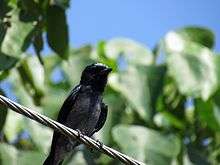Sri Lanka drongo
The Sri Lanka drongo (Dicrurus lophorinus) or Ceylon crested drongo, is a species of bird in the family Dicruridae. It is endemic to Sri Lanka. It was previously considered a subspecies of the greater racket-tailed drongo. Its natural habitats are subtropical or tropical moist lowland and montane forests.
| Sri Lanka drongo | |
|---|---|
 | |
| Scientific classification | |
| Kingdom: | Animalia |
| Phylum: | Chordata |
| Class: | Aves |
| Order: | Passeriformes |
| Family: | Dicruridae |
| Genus: | Dicrurus |
| Species: | D. lophorinus |
| Binomial name | |
| Dicrurus lophorinus (Viellot, 1817) | |
Taxonomy
Dicrurus lophorinus Vieillot, 1817, was in the past been placed in monospecific Dissemurulus, or in Dissemuroides. May form a super species with D. paradiseus, often treated as conspecific, but differs in tail morphology and probably in voice. Molecular-genetic studies required in order to elucidate taxonomic status. Few inter grades with race ceylonicus of D. paradises formerly reported along border between wet and dry zones, but interbreeding not now possible, since suitable habitat no longer remains between the two ecological zones, now completely separated.
Distribution
The species can be found throughout Wet zone of South Western parts of Sri Lanka, from Deduru Oya to Walawe.
Identification
- Black plumage with metallic blue or greenish-blue gloss
- Arching, helmet-like crest
- Deeply forked tail
- Red eye
- Sexes similar
Behavior
It is a forest bird as other drongos that can is confined to forest edges, plantations, and wooded gardens. Like most drongos, it feeds on insects from open perches. A superb mimic of the calls of other birds but always has a metallic sound.
References
- BirdLife International. 2017. Dicrurus lophorinus (amended version of 2016 assessment). The IUCN Red List of Threatened Species 2017: e.T103711132A111467183. https://dx.doi.org/10.2305/IUCN.UK.2017-1.RLTS.T103711132A111467183.en. Downloaded on 11 December 2018.
- Rasmussen, P.C., and J.C. Anderton. 2005. Birds of South Asia. The Ripley guide. Volume 2: attributes and status. Smithsonian Institution and Lynx Edicions, Washington D.C.
- http://www.ceylonbirdclub.org/ceylon_bird_club_search.php?id=48
